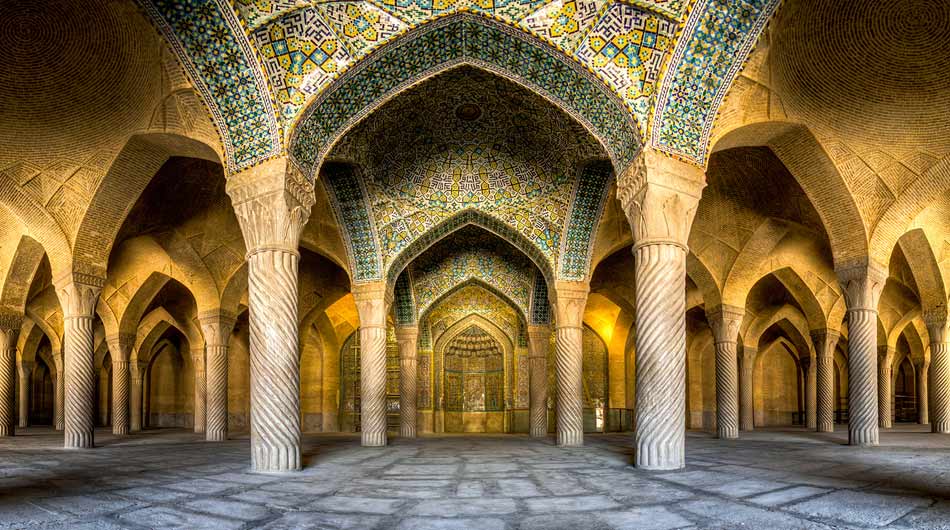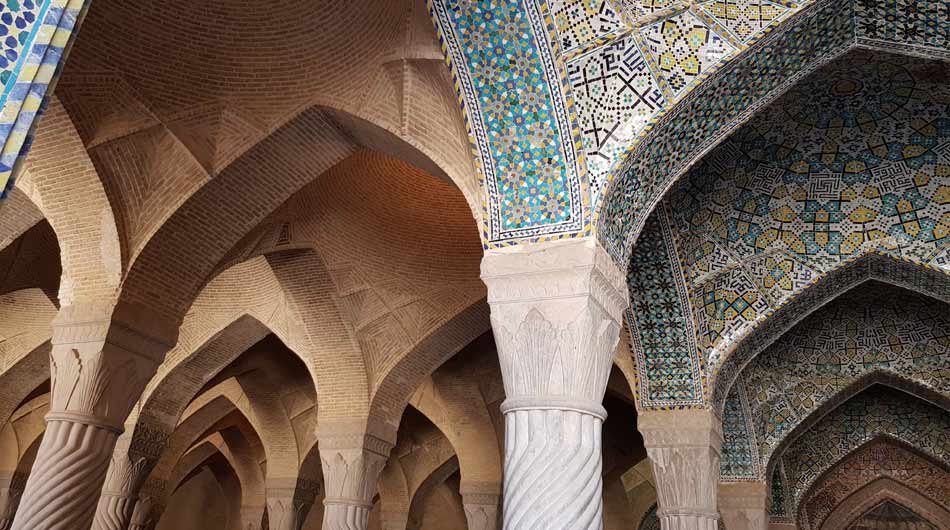Vakil Mosque in Shiraz: A Masterpiece of Persian Architecture
Nestled in the heart of the historic city of Shiraz, the Vakil Mosque stands as a testament to the rich cultural and architectural heritage of Iran. This 18th-century mosque, constructed during the Zand dynasty under the orders of Karim Khan Zand, is a stunning example of Persian art and architecture. With its intricate tilework, grand arches, and serene courtyards, Vakil Mosque continues to attract visitors from around the world. In this article, we delve into the history, architecture, and significance of this magnificent structure.
Historical Background
The Vakil Mosque, or Masjed-e Vakil, was built between 1751 and 1773, during the reign of Karim Khan Zand, who founded the Zand dynasty. The term “Vakil” translates to “regent,” a title that Karim Khan adopted for himself, reflecting his role as the ruler and protector of Persia. Located near the Vakil Bazaar and Vakil Bath, the mosque was part of a larger urban plan aimed at revitalizing Shiraz as a political and economic center.
Karim Khan Zand’s vision was to create a mosque that not only served as a place of worship but also as a symbol of the Zand dynasty’s power and cultural sophistication. Over the centuries, the Vakil Mosque has undergone several restorations, ensuring that it remains one of the most well-preserved examples of Zand architecture.
Architectural Marvel
The architecture of Vakil Mosque is a brilliant synthesis of traditional Persian design elements and innovative construction techniques. The mosque covers an area of approximately 8,660 square meters and features a large prayer hall, two iwans (rectangular halls with one open side), and an expansive courtyard.
Entrance and Courtyard
Visitors enter the mosque through a grand portal adorned with exquisite tilework that showcases floral motifs and Quranic inscriptions. This entrance leads into a spacious rectangular courtyard, surrounded by arcades on three sides. The courtyard is paved with stones and features a central pool, which adds to the mosque’s serene atmosphere.
Prayer Hall
The main prayer hall, known as Shabestan, is an architectural masterpiece. It spans 2,700 square meters and is supported by 48 monolithic stone columns, each carved with spiraling patterns. These columns create a mesmerizing visual effect and demonstrate the craftsmanship of the Zand period. The vaulted ceiling of the prayer hall is decorated with intricate tilework in shades of blue, green, and gold, forming geometric patterns and arabesques.
Mihrab and Minbar
At the far end of the prayer hall is the mihrab, a niche that indicates the direction of Mecca. The mihrab of Vakil Mosque is a stunning example of Persian artistry, adorned with detailed tile mosaics and calligraphy. Adjacent to the mihrab is the minbar, a pulpit from which the imam delivers sermons. The minbar is made of finely carved wood, featuring floral designs and inscriptions.
Iwans
The mosque features two iwans, one on the northern side and the other on the southern side of the courtyard. These iwans are characterized by their high arches and intricate tilework, which includes verses from the Quran and intricate floral designs. The northern iwan leads to the prayer hall, while the southern iwan provides access to additional prayer rooms.
Significance and Legacy
Vakil Mosque is not just an architectural gem; it holds immense cultural and religious significance. It serves as a place of worship for the local community and is a center for Islamic education and cultural activities. The mosque’s design reflects the aesthetic sensibilities of the Zand dynasty and their commitment to preserving Persian artistic traditions.
The intricate tilework and calligraphy found throughout the mosque are remarkable examples of Persian decorative arts. These elements not only enhance the beauty of the mosque but also convey religious and spiritual messages, creating a space that inspires contemplation and reverence.
Preservation and Tourism
Over the years, various restoration efforts have been undertaken to preserve the Vakil Mosque’s architectural integrity and historical value. These efforts ensure that future generations can continue to appreciate this remarkable example of Persian architecture.
Today, Vakil Mosque is a popular tourist destination, attracting visitors from around the world who come to marvel at its beauty and learn about its history. The mosque’s serene environment, coupled with its stunning architecture, offers a unique experience for travelers and a glimpse into Iran’s rich cultural heritage.
Tags:Adventure holidays, Best time to travel to iran, best tour operator iran, Cultural sites of Iran, Holiday in Iran, Iran, Iran Architectural, iran attractions, iran destinations, Iran sightseeing tours, iran Solo trip, iran tour, Iran tour packages, iran tourist attractions, Iran travel agency, iran travel expenses, Iran Travel Guide, Iran Travel Tips, must-visit Iran, persia tour, Shiraz, Shiraz attractions, top tourist destinations, travel to iran, travelling to iran, trip to iran, vacation packages, Vakil mosque, visit iran, درناگشت




helloI like your writing very so much proportion we keep up a correspondence extra approximately your post on AOL I need an expert in this space to unravel my problem May be that is you Taking a look forward to see you
child porn
child teen porn
child teen
child teen
I simply could not go away your web site prior to suggesting that I really enjoyed the standard info a person supply on your guests Is going to be back incessantly to investigate crosscheck new posts
Attractive section of content I just stumbled upon your blog and in accession capital to assert that I get actually enjoyed account your blog posts Anyway I will be subscribing to your augment and even I achievement you access consistently fast
Your blog is a constant source of inspiration for me. Your passion for your subject matter is palpable, and it’s clear that you pour your heart and soul into every post. Keep up the incredible work!
Hi Neat post Theres an issue together with your web site in internet explorer may test this IE still is the marketplace chief and a good component of people will pass over your fantastic writing due to this problem
Hey there You have done a fantastic job I will certainly digg it and personally recommend to my friends Im confident theyll be benefited from this site
xnxx
xnxx
Its like you read my mind You appear to know a lot about this like you wrote the book in it or something I think that you could do with some pics to drive the message home a little bit but instead of that this is fantastic blog An excellent read I will certainly be back
betturkey
dentavim scam: dentavim scam
potentstream scam: potentstream scam
denticore scam: denticore scam
FemiPro scam: FemiPro scam
Quietum Plus scam: Quietum Plus scam
Is MitoThrive a scam, or is it legitimate?: mitothrive scam
Is NeuroPrime a Scam or Legit?: NeuroPrime scam
Is Cacao Bliss a scam or is it a legitimate product?: Cacao Bliss scam
Is SonoVive a scam or a legitimate supplement?: sonovive scam
Is Pineal Pure a scam or is it legitimate?: pineal pure scam
Is Cacao Bliss a scam or is it a legitimate product?: Cacao Bliss scam
is DentiCore a scam, or is it a legitimate product that could help improve your oral health?: DentiCore scam
is DentiCore a scam, or is it a legitimate product that could help improve your oral health?: DentiCore scam
Is Pineal Pure a scam or is it legitimate?: pineal pure scam
Is NeuroPrime a Scam or Legit?: NeuroPrime scam
Is AppaNail a Scam or Legit?: AppaNail scam
Is Pineal Pure a scam or is it legitimate?: pineal pure scam
Is AppaNail a Scam or Legit?: AppaNail scam
Is ProvaDent a Scam or Legit?: provadent scam
is DentiCore a scam, or is it a legitimate product that could help improve your oral health?: DentiCore scam
is DentiCore a scam, or is it a legitimate product that could help improve your oral health?: DentiCore scam
Is Cacao Bliss a scam or is it a legitimate product?: Cacao Bliss scam
is DentiCore a scam, or is it a legitimate product that could help improve your oral health?: DentiCore scam
Is Pineal Pure a scam or is it legitimate?: pineal pure scam
Is Pineal Pure a scam or is it legitimate?: pineal pure scam
Really impressed by how data-driven Lotto Champ is. It’s
not just lucky numbers—it actually analyzes trends.
I don’t expect to get rich overnight, but it’s definitely added a smarter edge to how I
play.
Stop by my web site: lotto champ reviews